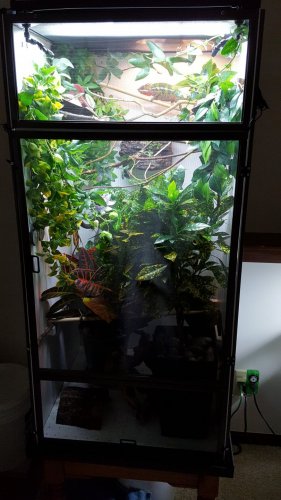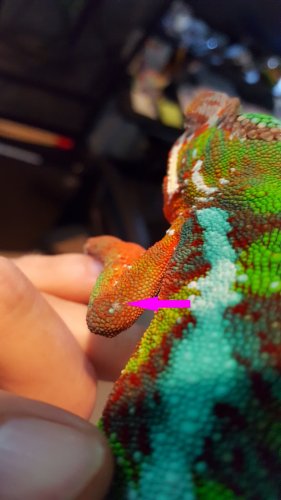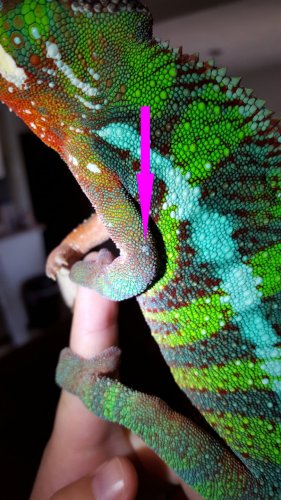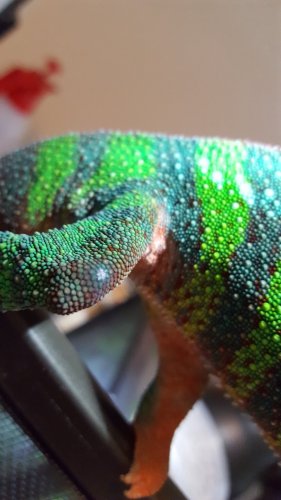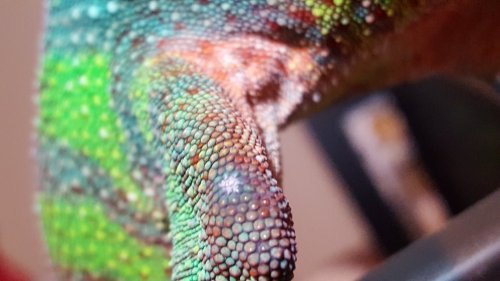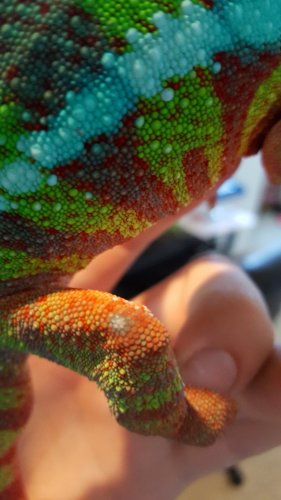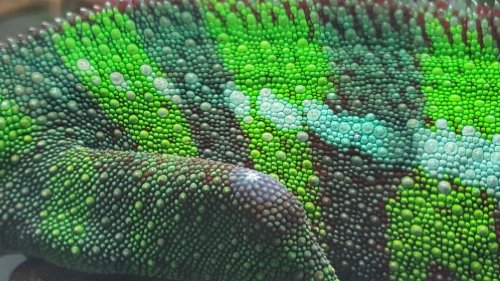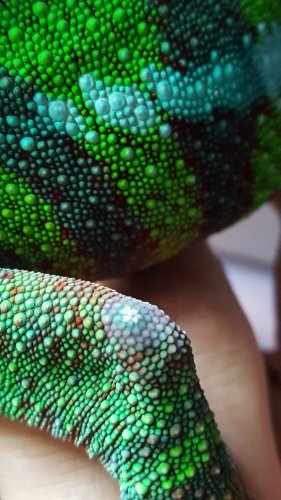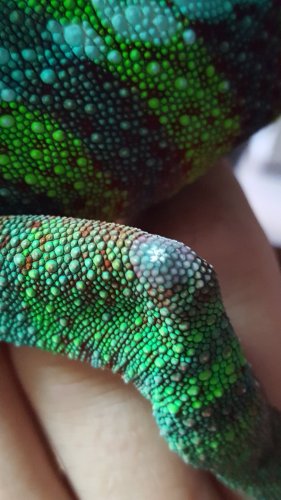trickedoutbiker
Avid Member
Chameleon Info:
Cage Info:
Current Problem - I have noticed recently some small white / gray spots on my chameleon. The look a little discolored. One spot is on his back-right leg, and one spot is on his front-left leg. At first I thought maybe they were stuck shed spots, but I can't seem to get them off with a wet Q-tip. I did a little reading and saw some people with spots here on the forums that looked similar, but not exact, and those peeps were told they might be thermal burns. I can't see that this could be the cause just because of the placing of the spots on his body. If he has thermal burns on his arms, I would think they would be on his head and his back or tail as well since those areas of the body are closer to the basking bulbs. I could be wrong though? I slightly adjusted his basking bulbs a week ago that way when he sits under them, he is no longer DIRECTLY under them, but instead, he is down and slightly off center of the bulb. I did this that way he can still be nice and warm, but he won't be DIRECTLY under the bulb until I can figure out what is going on. Even with the two bulbs I have, no part on his branch is ever over 90 degrees, staying mostly at 88. The hottest I have ever seen my cham's body is 92 on the very top of his back in the summer, and that was before I moved the lights slightly so now he doesn't get more than 90 himself. 2 extra degrees probably doesn't matter a WHOLE lot though either, as he knows quite well how to thermo-regulate and they also experience temps higher than that sometimes in the wild. Anyways.....
What could this possibly be? I'm pondering whether he needs to see a vet or not, because I want to nip this in the butt before it becomes something bad. Can anyone give me some help or insight to what this may be?
I have attached here, a pic of my cage. If you want to see better pics, just ask. I am also doing a cage review thread here soon. Been meaning to do it earlier but I wanted all my plants to grow out nice and good before I do it.

- Your Chameleon - Ambilobe Panther Chameleon. Male. About a year old. Been in my care since October 2015.
- Handling - About once a week to take him outside for sun. Sometimes 2x a week.
- Feeding - Chameleon gets crickets, Dubia, hornworms, superworms, butterworms, flies, BSF and their larvae, mantids, butterflies, dragonflies, cicadas.... He eats every other day. I am gutloading my Dubia with roach chow from DubiaRoaches.com. All other grain based feeders such as the superworms and the crickets get Cricket Crack. For wet gutload, all insects (that will eat it) get kale, mustard greens, collard greens, turnip greens, apples, oranges, strawberries, blueberries, shredded carrots, small pieces of kiwi fruit, cucumber, watermelon..... All feeders have dry gutload and wet gutload 100% of the time, all hours of the day.
- Supplements - Currently using Exo Terra calcium without D3 lightly dusted at every feeding. I was using Zoo Med's calcium without D3 but I ran out, and my gf got me some of the Exo Terra calcium without D3 back so I started using that now. I also use Zoo Med's REPTIVITE multivitamins with D3 added and I use this once every two weeks on a Sunday because it contains both vitamins and D3. I dust a few insects when I give him this.
- Watering - I have a MistKing Starter System. The schedule is as follows:
8:30 AM (this is one hour after lights come on) - 1 minute
10:30 AM - 4 minutes
2:30 PM - 5 minutes
6:30 PM - 1 minute
8:30 PM - 5 seconds (to add a tad bit of humidity to the air before lights off)
I also have a BIG DRIPPER that I turn on when I get home from work at 4 PM and I let it run until the lights go off. It drips about once every second or once every other second.
I have seen him drink many times, but it's usually when I sneak up on him, as I think he is a little shy to drink in front of anyone.
- Fecal Description - Never been tested for parasites. The droppings are always a nice brown, not too dry and not runny. There is always white in his urates with just a small hint of orange, not enough to alarm me to dehydration. His eyes are big like blueberries... I'm sure he is getting enough water. I'd love for his poop to be white as snow every single time.... but wish in one hand and well, you know....
- History - Got him when he was 3 months old. I always try to offer him a wide variety of feeders and I always offer the feeders a wide variety of gutload as well.
Cage Info:
- Cage Type - 24 x 24 x 48 X-Large Breeder Series Dragon Strand with the 3 white PVC sides and the door and top are screen.
- Lighting - LightYourReptiles Tropic Blaze Quad Fixture. This has two 6500k bulbs in it for lighting, one Plant Pro bulb, and one Reptisun 10.0 T5 High Output UVB light. All these lights are brand new as of May 1st. For basking, I have a dual dome fixture which holds a 60 watt incandescent in one slot and a 100 watt incandescent in the other slot. The reason I have two heat bulbs is because I have come home before to a cage which had a basking bulb blow out, and my chameleon looked like he was cold all day (this winter when this happened, twice). So now I use two basking bulbs so that in case one of them ever goes out, there is at least SOMETHING putting heat into the cage for him to sit under.
The 100 watt bulb is on a dimmer switch and I adjust it so that, combined with the 60 watt bulb, the basking spot is always around 88-90 degrees. The temps in my house fluctuate with the seasons, but it is never colder than 68 degrees in my house at the coldest and it is never higher than 75 degrees in the house at the highest. If it gets a little cooler in the house, I turn the 100 watt bulb up just a hair. If it's more towards 75 degrees in my house, then I turn the 100 watt bulb down just a hair. Light schedule is as follows:
7:30 AM - UVB bulb and Plant Pro bulb come on, as well as the two basking bulbs. (sunrise)
9:30 AM - the two 6500k daylight bulbs come on. (midday)
7:30 PM - the two 6500k daylight bulbs go off, leaving the UVB and Plant Pro bulbs on. (sunset)
9:00 PM - the last two linear bulbs (UVB and Plant Pro) go out, as well as the two basking bulbs. (night)
9:00 - 9:30 - the blue LED lights from the quad fixture come on to give the chameleon time to find his sleeping spot (99% of the time, he is already in his sleep spot). This is is moonlight phase before all lights go out 100% at 9:30 PM.
Now, I realize that for total, from first lights on till blue LED's go off, that it is 14 hours of light and not 12. Really, it is 13.5 hours of light and .5 hours of the moonlight blue LEDS..... but 14 total. I am fully aware of this. Reason I do this is because in the summer, there are scientifically more hours of daylight across much of the globe. I am simulating this as best I can. Hence, the same reason I have my bulbs on different timers to simulate sunrise, midday, sunset, and night time. In a few weeks, I will decrease the light time by half hour. Then a few weeks later, I will do it again. And again. Until there are 12 hours of light / 12 hours of darkness for winter, all winter. Then come spring, I will slowly increase the amount of light by half hour every few weeks until I am back at the schedule I am on now.
ALSO - with the change of lights times, I will also slightly re-adjust my misting times so that way they are on par with my light schedule.
- Temperature - in the winter, the cage bottom a few inches up from the floor is about 70 degrees, as the temps in my house are typically around 68-70. In the summer, the cage bottom is more towards 74-75, as my house never gets hotter than 75.
As you move up the cage, it becomes warmer, and gets higher the higher up you go. Depending on whether it is winter or summer, these numbers are a little different. In winter, the cage middle is about 74-76 and in the summer it is about 75-78 in the middle. A little warmer in the summer, a little cooler in the winter.The top of the cage is about 78-80 when not under the heat lamp, no matter the season, as the quad fixture puts off a bit of heat up there as well. Never gets hotter than 80 at the top anywhere (besides under the basking lights). As I sit here typing this, a probe 6 inches directly under the quad fixture is reading out at 77.4 degrees and it is 75 degrees in my house and 93 degrees outside. Directly under the basking bulb about 5-6 inches down is 88-90 degrees on the probe I have set up. When my chameleon is basking, I have hit him with the temp gun ray a few times and have never seen his actual body temp go higher than 92 in the summer, meaning it would be a little cooler in the winter given that the ambient temp of the room is a tad cooler. The lowest overnight temps ever are 68 degrees, because like I mentioned, I don't let my house fall below 68 degrees.
To measure the temps, I have a Zoo Med dual hygrometer/temperature dial gauge near the bottom of the cage. This is to measure the bottom'ish temps and humidity. I also have two dial gauges in the middle of the cage from Petco, one of which measure humidity and one which measures temperature. This is to measure the middle'ish temps and humidity of the cage. At the top of the cage, there is a Zoo Med temperature probe on a branch 6 inches below the quad fixture - this is to tell me what the highest temps are at the top of the cage without sitting directly under the actual basking bulb. Under the basking bulb itself, about 5-6 inches down on a branch, there is a probe which measures the temperature. The probe is part of the Zilla hygrometer / temperature unit which has two probes with it. The other probe, a humidity probe, is tucked into some plants in the middle / back of the cage, so really, I have two probes monitoring the middle'ish humidity in the cage. - one near the front of the cage and one near the back.
To even further the accuracy of everything, I have a temp gun I can use to scan any given part of the cage, or the chameleon itself, to see what the precise temps are of that particular area or section.
- Humidity - The humidity in the cage is 55-60% at the lowest point between any given misting session, with huge spikes up to the mid 80's or a little more when the mister goes off. I check humidity as stated above, with one dial gauge at the bottom of the cage, one dial gauge in the middle/front of the cage, and one probe in the middle/back of the cage. This gives me a pretty accurate reading of the humidity gradients throughout the cage.
- Plants - I have a 3 small fake plant pieces to kind of cover some of the white walls, but there are also 11 live plants in my cage. All are different plants. If it's really that relevant, I can list them all out here, but I don't honestly find that necessary, as all of the plants are pulled from the SAFE PLANT lists I've seen, and he does not eat them. There are also lots of branches and vines hidden throughout the cage for multiple climbing opportunities.
- Placement - Cage is located in my living room, in the furthest corner from any traffic. We spend time in the living room sure, but with the white walls of the cage, the chameleon is pretty secluded and doesn't really see us unless we are actually standing right in front of his cage. He is pretty friendly and likes to crawl to the front of the cage when he does see someone though, as he has learned long ago to associate people with good things such as real sunshine and food. The cage is not next to any fans or vents, although there is a vent across the room from him. This does not affect him though, as I have held a lighter to the front of the whole cage front as the air was blowing out the vents and the flame of the lighter did not flicker. The cage is sitting on a wooden stand which is about 2 feet high, giving the height at the top of the cage about 6 feet off the ground.
- Location - I am located in Indianapolis, IN in the United States.
Current Problem - I have noticed recently some small white / gray spots on my chameleon. The look a little discolored. One spot is on his back-right leg, and one spot is on his front-left leg. At first I thought maybe they were stuck shed spots, but I can't seem to get them off with a wet Q-tip. I did a little reading and saw some people with spots here on the forums that looked similar, but not exact, and those peeps were told they might be thermal burns. I can't see that this could be the cause just because of the placing of the spots on his body. If he has thermal burns on his arms, I would think they would be on his head and his back or tail as well since those areas of the body are closer to the basking bulbs. I could be wrong though? I slightly adjusted his basking bulbs a week ago that way when he sits under them, he is no longer DIRECTLY under them, but instead, he is down and slightly off center of the bulb. I did this that way he can still be nice and warm, but he won't be DIRECTLY under the bulb until I can figure out what is going on. Even with the two bulbs I have, no part on his branch is ever over 90 degrees, staying mostly at 88. The hottest I have ever seen my cham's body is 92 on the very top of his back in the summer, and that was before I moved the lights slightly so now he doesn't get more than 90 himself. 2 extra degrees probably doesn't matter a WHOLE lot though either, as he knows quite well how to thermo-regulate and they also experience temps higher than that sometimes in the wild. Anyways.....
What could this possibly be? I'm pondering whether he needs to see a vet or not, because I want to nip this in the butt before it becomes something bad. Can anyone give me some help or insight to what this may be?
I have attached here, a pic of my cage. If you want to see better pics, just ask. I am also doing a cage review thread here soon. Been meaning to do it earlier but I wanted all my plants to grow out nice and good before I do it.
